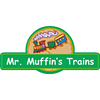Resources
About & Contact Us


MTH 20-3942-1 - 4-6-6-4 Z-6 Challenger Steam Engine "Spokane, Portland & Seattle" #905 w/ PS3
- Sale price
- $ 1,529.96
- Regular price
- $ 1,699.95
- You save
- $ 169.99 (10%)
Product Information
| Announced Date: | April 2024 |
| Released Date: | Feb 2025 |
| Individually Boxed: | Yes |
- Road Name: Spokane Portland & Seattle
- Road Number: 905
- Product Line: Premier
- Scale: O Scale
Features:
- Intricately Detailed, Die-Cast Boiler and Chassis
- Intricately Detailed, Die-Cast Tender Body
- Authentic Paint Scheme
- Die-Cast Locomotive Trucks
- Handpainted Engineer and Fireman Figures
- Metal Handrails, Whiste and Bell
- Metal Wheels and Axles
- Remote Controlled Proto-Coupler
- O Scale Kadee-Compatible Coupler Mounting Pads
- Prototypical Rule 17 Lighting
- Constant Voltage LED Headlight
- Operating LED Firebox Glow
- Operating LED Marker Lights
- Operating LED Numberboard Lights
- Lighted LED Cab Interior
- Operating Tender LED Back-up Light
- Powerful 7-Pole Precision Flywheel-Equipped Motor
- Synchronized Puffing ProtoSmoke System
- Steaming Quillable Whistle
- Locomotive Speed Control In Scale MPH Increments
- Wireless Drawbar
- 1:48 Scale Dimensions
- Onboard DCC/DCS Decoder
- Proto-Scale 3-2 3-Rail/2-Rail Conversion Capable
- Real Tender Coal Load
- Proto-Sound 3.0 With The Digital Command System Featuring Quillable Whistle With Freight Yard Proto-Effects
- Unit Measures: 30 3/4" x 2 1/2" x 4"
- Operates On O-72 Curves
Steam DCC Features
- F0 Head/Tail light
- F1 Bell
- F2 Horn
- F3 Start-up/Shut-down
- F4 PFA
- F5 Lights (except head/tail)
- F6 Master Volume
- F7 Front Coupler
- F8 Rear Coupler
- F9 Forward Signal
- F10 Reverse Signal
- F11 Grade Crossing
- F12 Smoke On/Off
- F13 Smoke Volume
- F14 Idle Sequence 3
- F15 Idle Sequence 2
- F16 Idle Sequence 1
- F17 Extended Start-up
- F18 Extended Shut-down
- F19 Labor Chuff
- F20 Drift Chuff
- F21 One Shot Doppler
- F22 Coupler Slack
- F23 Coupler Close
- F24 Single Horn Blast
- F25 Engine Sounds
- F26 Brake Sounds
- F27 Cab Chatter
- F28 Feature Reset
Overview:
In the early part of the twentieth century, most freight moved in relatively slow “drag” freight trains, and speed was secondary to just getting the goods delivered. The introduction of “super-power” steam technology in the 1920’s, however, enabled builders to create freight locomotives that combined speed and power. Perhaps the zenith of the fast freight engine was the 4-6-6-4 Challenger, first conceived by the Union Pacific Railroad and American Locomotive Works in the mid-1930s. The Northern Pacific liked what it saw taking shape at Alco and ordered its own, even bigger Challengers. One reason the NP engines were larger was the railroad’s use of large fireboxes to burn low-quality Rosebud coal mined online in Montana — coal that at least one fireman described as “damned close to dirt.” The first dozen Z-6 Challengers arrived in 1936, just months after the UP received its own first Challengers. Like 4-6-6-4s on the UP and the Western Maryland, the articulated Z-6s replaced older, slower rigid-frame engines — doubleheaded Mikados in the Northern Pacific’s case. The Z-6s spent most of their careers hauling reefer trains and fast freights on Northern Pacific divisions in Washington State and Montana’s Big Sky country, with occasional passenger stints leading the crack North Coast Limited. Sixty-nine inch drivers allowed a Z-6 to maintain 60 mph on the plateaus between the Northwest’s mountain ranges.
The Northern Pacific was pleased enough with its new articulateds to order nine more Z-6s in 1937. The same year, an additional six engines were ordered for the Spokane, Portland & Seattle, a jointly-owned subsidiary of the NP and the Great Northern. The SP&S engines were oil burners, but virtually identical to the NP Z-6s in every other way. Two of the SP&S engines were later sold to the Great Northern for use in Washington and Oregon. For a time in the late steam era, the thundering Z-6 was indeed the Northwest’s own articulated.
We Accept
Recommended for You
Browsing history
- Choosing a selection results in a full page refresh.
Get in touch
177 W Main St
Atlanta, IN 46031
765-292-2022
support@mrmuffinstrains.com
Keep in Touch
Sign up for our newsletter and be the first to know about coupons and special promotions.
Country/region
© 2025, MrMuffin'sTrains Powered by Shopify
